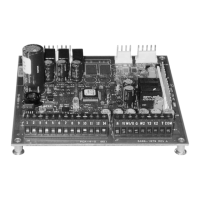RT-SVD03G-EN 91
ReliaTel Hot Surface Ignition Control (12.5 - 50 Ton 1 Stage, 2 Stage, and Modulating Gas Heat)
Sequence of Operations (1 and 2 heat units)
The 12½ through 50 ton packaged units use a drum and tube heat exchanger with a negative
pressure gas valve and hot surface ignition. This design is the same as was used with the UCP micro
controls, but the control circuitry for ignitions has changed to take advantage of ReliaTel MODBUS
communications.
When the system switch is set to the "Heat" position and the zone temperature falls below the
heating setpoint, a heat cycle is initiated when the RTRM communicates ignition information to the
ignition module (IGN).
The IGN runs a self-check (including verification that the gas valve is de-energize). IGN checks the
high-limit switches (TC01 & TCO2) for normally closed contacts. With 115 vac supplied to the
ignition module (IGN), the hot surface ignitor probe (IP) is preheated for approximately 45 seconds.
The gas valve (GV) is energized for approximately 7 seconds for trial ignition to ignite the burner.
Once the burner is ignited, the hot surface ignition probe (IP) is de-energized by the ignition module
and then functions as the flame sensor. The unit initially fires on high heat, but after approximately
60 seconds, if no additional heating is required, the ignition module will drop back to low heat.
When the fan selection switch is set to the "AUTO" position, the RTRM energizes the indoor fan relay
(F) approximately 45 seconds after initiating the heating cycle to start the indoor fan motor (IDM).
If the burner fails to ignite, the ignition module will attempt two more ignition cycles before locking
out. The green LED will indicate a lockout by two fast flashes. An ignition lockout can be reset by:
4. Opening for 3 seconds and closing the main power disconnect switch,
5. By switching the "Mode" switch on the zone sensor to "OFF" and then to the desired position, or
6. Allowing the ignition control module to reset automatically after one hour.
If the burner trips due to a high temperature limit, the unit will shut down and initiate a four flash
diagnostic. After the limit cools down and closes, the burner will again restart. There is no limit to
the number of high limit trips that can occur.
When the RTRM is communicating with the ignition module (IGN), the MODBUS voltage can be
measured at the 3J5 plug, pins 3 (negative) and 4 (positive). The voltage will be flashing at
approximately 10.7 to 9.6 vdc at a rate of once every three seconds. If the 3J5 plug is disconnected,
the measured voltage at pins 3 and 4 on the RTRM will be approximately 10.5 to 11.2 vdc and will
be flashing. Flame current measurements can also be made at two pins on the ignition module
labeled "FLAME CHECK" located at the bottom of the module. Flame current can be measured with
a DC voltmeter. One volt dc equals one microamp of flame current (1vdc = 1mA).
27.5 - 50 ton "high heat" units use two drum and tube heat exchangers. Two ignition controls work
in tandem to provide heat as required.
Figure 55. ReliaTel Hot Surface Ignition Control Sequence of Operation
1st Stage Call
for Heat
Ignitor
Starts Heating
Combustion
Fan On
60 sec.
Start Trial
for Ignition
1st Stage
Heat On
Start 45 sec
timing for
ID fan
ID fan
starts
Heater goes
to low fire
Heater goes
to 2nd stage
Heating Call
Terminates
Combustion
Fan Off
ID Fan
Continues to
Run for 60 sec.
Indoor
Fan
Shuts Off
If a Call for 2nd
Stage, Heater
Stays on High Fire
Fires on
High Heat
Time will vary
depending on call
for 2nd stage
45 sec.
7 sec.
45 sec.
1 min.

